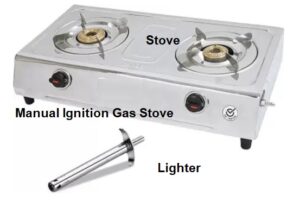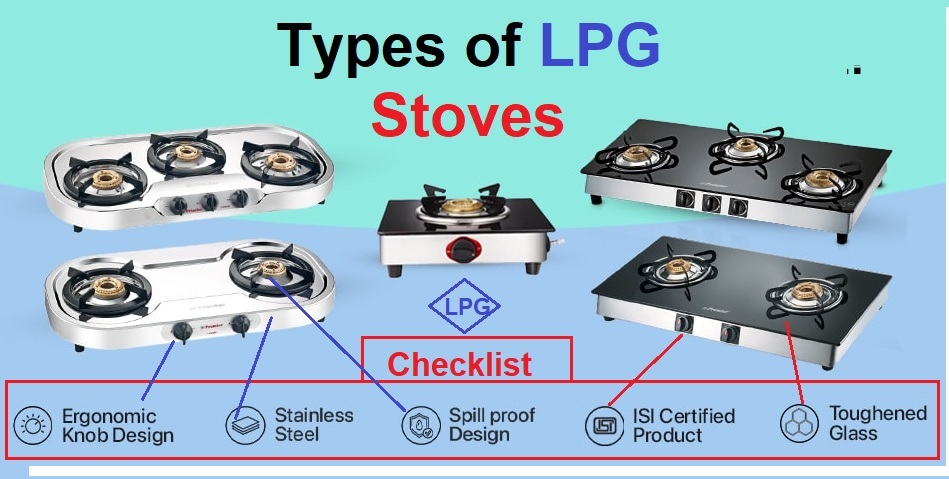Gas stoves with Different Ignition System
- There are mainly two types of LPG gas stoves:
- Manual Ignition Gas Stove:
- A manual ignition gas stove requires a lighter or a matchstick to ignite the flame.
- The user needs to manually light the flame by placing the matchstick or lighter close to the burner and turning on the knob to release the gas.
- These types of stoves are generally cheaper and easier to use, but they require an external source of ignition.
- Standing Pilot Light:
- In a standing pilot ignition system, a small, continuously burning flame (the pilot light) is located near the burner.
- When you turn on the burner, the gas flows to the pilot light, which then ignites the burner.
- This system is less common in newer stoves but is still found in some older models.
- Battery-Powered Ignition:
- Some gas stoves use battery-powered ignition systems that work similarly to electric ignition
- However these burners are powered by a battery instead of being connected to your household electricity.
- Hot Surface Ignition:
- In hot surface ignition systems, a hot ceramic or metal surface heats up when you turn on the burner.
- Once it reaches a high temperature, it ignites the gas.
- This type of ignition is commonly found in high-end gas stoves and cooktops.
- Flame Sensing Ignition:
- Flame sensing ignition systems use a sensor to detect the presence of a flame.
- If the sensor doesn’t detect a flame after a few seconds of attempting ignition, it shuts off the gas flow as a safety precaution.
- Automatic Ignition Gas Stove:
- An automatic ignition gas stove comes with an inbuilt ignition system that generates a spark to ignite the gas when the knob is turned on.
- These stoves are also known as auto-ignition gas stoves or electronic ignition gas stoves.
- They are generally more expensive than manual ignition stoves but are convenient to use and eliminate the need for an external ignition source.
- Automatic ignition gas stoves can further be classified into two types:
- Battery Operated Automatic Ignition Gas Stove:
- These types of stoves have an inbuilt battery that powers the ignition system.
- The battery needs to be replaced periodically.
- Electrically Operated Automatic Ignition Gas Stove:
- These types of stoves have an inbuilt electrical circuit that powers the ignition system.
- The ignition system works on electricity and is connected to a power source.
- Battery Operated Automatic Ignition Gas Stove:
Manual Ignition Gas Stove
- A manual ignition gas stove is a type of LPG gas stove that requires an external source of ignition to light the flame.
- The user needs to manually ignite the gas using a lighter or a matchstick.
- The manual ignition gas stove has a control knob that regulates the flow of gas to the burner
- .When the knob is turned on, gas starts flowing through the burner holes, and the user needs to hold a matchstick or lighter close to the burner to ignite the flame.
- Once the flame is ignited, the user can adjust the flame’s intensity by turning the knob to increase or decrease the gas flow. When the user is done cooking, they can turn off the knob, and the flame will go out, stopping the gas flow to the burner.
- Manual ignition gas stoves are generally cheaper and simpler than automatic ignition gas stoves. However, they require an external source of ignition and may not be as convenient to use as auto-ignition stoves.
- Additionally, manual ignition stoves may not be as safe as auto-ignition stoves since they can pose a risk if the user forgets to turn off the gas knob. It is important to follow the manufacturer’s instructions and safety guidelines when using a manual ignition gas stove.

Automatic Ignition Gas Stove
- An automatic ignition gas stove is a type of LPG gas stove that comes with an inbuilt ignition system that generates a spark to ignite the gas when the knob is turned on. These stoves are also known as auto-ignition gas stoves or electronic ignition gas stoves.
- The automatic ignition gas stove has a control knob that regulates the flow of gas to the burner. When the knob is turned on, the inbuilt ignition system generates a spark that ignites the gas, eliminating the need for an external ignition source like a matchstick or lighter.
- Once the flame is ignited, the user can adjust the flame’s intensity by turning the knob to increase or decrease the gas flow. When the user is done cooking, they can turn off the knob, and the flame will go out, stopping the gas flow to the burner.

- Automatic ignition gas stoves are generally more expensive than manual ignition gas stoves but are more convenient to use since they eliminate the need for an external ignition source.
- Additionally, automatic ignition stoves are considered to be safer than manual ignition stoves since they come with safety features like flame failure protection, which automatically cuts off the gas supply if the flame goes out.
- Automatic ignition gas stoves can be further classified into two types: battery-operated and electrically operated, depending on the type of ignition system used.
- Battery-operated auto-ignition stoves have an inbuilt battery that powers the ignition system, while electrically operated auto-ignition stoves are connected to a power source and use an electrical circuit to generate the spark.
How to buy the best LPG Gas Stove for cooking
When buying the best LPG gas stove, there are several factors to consider:
Number of burners:
- Depending on your cooking needs, you can choose a gas stove with 2, 3, 4 or more burners.
- If you have a large family or regularly cook for guests, a gas stove with multiple burners may be suitable.
Type of ignition:
- You can choose between a manual ignition gas stove or an automatic ignition gas stove.
- Automatic ignition gas stoves are more convenient, but manual ignition gas stoves are generally less expensive.
Material:
- Gas stoves can be made of various materials such as stainless steel, glass, brass, etc.
- Stainless steel is durable and easy to clean, while glass top gas stoves are sleek and stylish.
- Brass burners are ideal for Indian cooking as they distribute heat evenly.
Size and space:
- Before buying a gas stove, make sure to measure the space available in your kitchen and choose a gas stove that fits in well. Also, consider the size of the burners, as larger burners are better for cooking with larger vessels.
Safety features:
- Look for gas stoves with features like flame failure protection, which automatically shuts off the gas supply if the flame goes out. Also, make sure that the gas stove has proper ventilation and is placed away from flammable materials.
Brand reputation:
- Choose a gas stove from a reputable brand that offers good after-sales service and warranty.
By considering these factors, you can choose the best LPG gas stove that meets your cooking needs and budget.
Issues in Gas stoves Burners
- Always exercise caution when working with gas burners appliances as LPG or CNG is highly flammable.
- There are some common issues you may face during its operations
- Burners does not show flame
- Igniter is not working
- Gas leakage or smell
- Yellow flames
- Longer or uneven flames
- You can get the solutions of above gas stove burner problems in the post of this website. Follow the checklist for better safety
